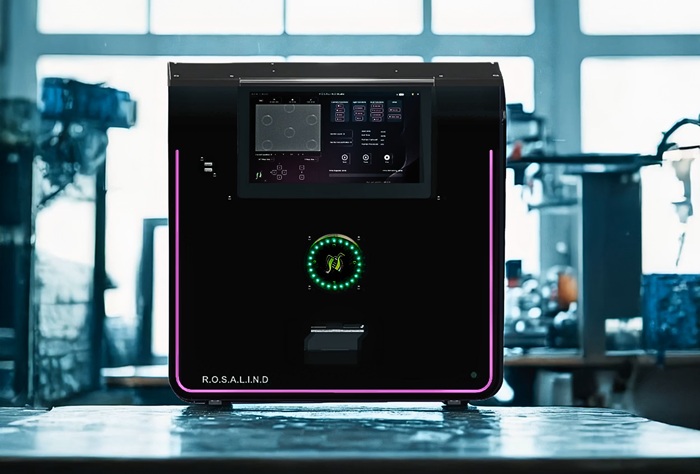Salivary Glucose Levels Measured by Biochip Sensor
|
By LabMedica International staff writers Posted on 18 Jun 2014 |
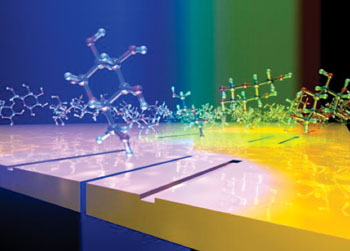
Image: The schematic shows glucose molecules sliding along the biochip sensor surface illuminated by different colors. Change in light intensity transmitted through the slits of each plasmonic interferometer can be used to measure the glucose concentration in saliva (Photo courtesy of Domenico Pacifici, PhD).
A new biochip sensor has been developed that can selectively measure concentrations of glucose in a complex solution similar to human saliva.
The new chip makes use of a series of specific chemical reactions combined with plasmonic interferometry which is a means of detecting chemical signature of compounds using light. The device is sensitive enough to detect differences in glucose concentrations that amount to just a few thousand molecules in the sampled volume.
Scientists at Brown University (Providence, RI, USA) exploited the synergistic advantage of combining plasmonic interferometry with an enzyme-driven dye assay that yields an optical sensor capable of detecting glucose in saliva with high sensitivity and selectivity. The biochip is made from a 2.54 x 2.54-cm piece of quartz coated with a thin layer of silver. Etched in the silver are thousands of nanoscale interferometers, tiny slits with a groove on each side. The grooves measure 200 nm wide and the slit is 100 nm wide.
When a liquid is deposited on the chip, the light and the surface plasmon waves propagate through that liquid before they interfere with each other. That alters the interference patterns picked up by the detectors, depending on the chemical makeup of the liquid. The scientists added microfluidic channels to the chip to introduce two enzymes that react with glucose in a very specific way. The first enzyme, glucose oxidase, reacts with glucose to form a molecule of hydrogen peroxide. This molecule then reacts with the second enzyme, horseradish peroxidase, to generate a molecule called resorufin, which can absorb and emit red light, thus coloring the solution. The team could then tune the interferometers to look for the red resorufin molecules.
The team tested its combination of dye chemistry and plasmonic interferometry by looking for glucose in artificial saliva, a mixture of water, salts and enzymes that resembles the real human saliva. They found that they could detect resorufin in real time with great accuracy and specificity. They were able to detect changes in glucose concentration of 0.1 μM/L, which is 10 times the sensitivity that can be achieved by interferometers alone. The proposed device is highly sensitive and highly specific for glucose sensing in picoliter volumes, across the physiological range of glucose concentrations found in human saliva, which is 20 μM–240 μM.
Domenico Pacifici, PhD, an assistant professor of engineering, and who led the study, said, “We have demonstrated the sensitivity needed to measure glucose concentrations typical in saliva, which are typically 100 times lower than in blood. Now we are able to do this with extremely high specificity, which means that we can differentiate glucose from the background components of saliva.” The study was published in the June 2014 edition of the journal Nanophotonics.
Related Links:
Brown University
The new chip makes use of a series of specific chemical reactions combined with plasmonic interferometry which is a means of detecting chemical signature of compounds using light. The device is sensitive enough to detect differences in glucose concentrations that amount to just a few thousand molecules in the sampled volume.
Scientists at Brown University (Providence, RI, USA) exploited the synergistic advantage of combining plasmonic interferometry with an enzyme-driven dye assay that yields an optical sensor capable of detecting glucose in saliva with high sensitivity and selectivity. The biochip is made from a 2.54 x 2.54-cm piece of quartz coated with a thin layer of silver. Etched in the silver are thousands of nanoscale interferometers, tiny slits with a groove on each side. The grooves measure 200 nm wide and the slit is 100 nm wide.
When a liquid is deposited on the chip, the light and the surface plasmon waves propagate through that liquid before they interfere with each other. That alters the interference patterns picked up by the detectors, depending on the chemical makeup of the liquid. The scientists added microfluidic channels to the chip to introduce two enzymes that react with glucose in a very specific way. The first enzyme, glucose oxidase, reacts with glucose to form a molecule of hydrogen peroxide. This molecule then reacts with the second enzyme, horseradish peroxidase, to generate a molecule called resorufin, which can absorb and emit red light, thus coloring the solution. The team could then tune the interferometers to look for the red resorufin molecules.
The team tested its combination of dye chemistry and plasmonic interferometry by looking for glucose in artificial saliva, a mixture of water, salts and enzymes that resembles the real human saliva. They found that they could detect resorufin in real time with great accuracy and specificity. They were able to detect changes in glucose concentration of 0.1 μM/L, which is 10 times the sensitivity that can be achieved by interferometers alone. The proposed device is highly sensitive and highly specific for glucose sensing in picoliter volumes, across the physiological range of glucose concentrations found in human saliva, which is 20 μM–240 μM.
Domenico Pacifici, PhD, an assistant professor of engineering, and who led the study, said, “We have demonstrated the sensitivity needed to measure glucose concentrations typical in saliva, which are typically 100 times lower than in blood. Now we are able to do this with extremely high specificity, which means that we can differentiate glucose from the background components of saliva.” The study was published in the June 2014 edition of the journal Nanophotonics.
Related Links:
Brown University
Latest Clinical Chem. News
- Noninvasive Blood-Glucose Monitoring to Replace Finger Pricks for Diabetics
- POC Breath Diagnostic System to Detect Pneumonia-Causing Pathogens
- Online Tool Detects Drug Exposure Directly from Patient Samples
- Chemical Imaging Probe Could Track and Treat Prostate Cancer
- Mismatch Between Two Common Kidney Function Tests Indicates Serious Health Problems
- VOCs Show Promise for Early Multi-Cancer Detection
- Portable Raman Spectroscopy Offers Cost-Effective Kidney Disease Diagnosis at POC
- Gold Nanoparticles to Improve Accuracy of Ovarian Cancer Diagnosis
- Simultaneous Cell Isolation Technology Improves Cancer Diagnostic Accuracy
- Simple Non-Invasive Hair-Based Test Could Speed ALS Diagnosis
- Paper Strip Saliva Test Detects Elevated Uric Acid Levels Without Blood Draws
- Prostate Cancer Markers Based on Chemical Make-Up of Calcifications to Speed Up Detection
- Breath Test Could Help Detect Blood Cancers
- ML-Powered Gas Sensors to Detect Pathogens and AMR at POC
- Saliva-Based Cancer Detection Technology Eliminates Need for Complex Sample Preparation
- Skin Swabs Could Detect Parkinson’s Years Before Symptoms Appear
Channels
Molecular Diagnostics
view channel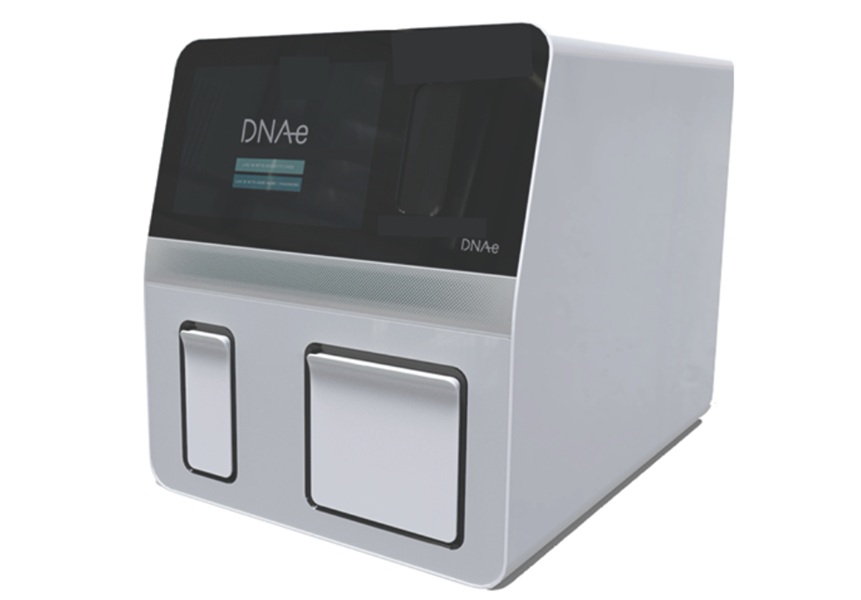
World's First NGS-Based Diagnostic Platform Fully Automates Sample-To-Result Process Within Single Device
Rapid point-of-need diagnostics are of critical need, especially in the areas of infectious disease and cancer testing and monitoring. Now, a direct-from-specimen platform that performs genomic analysis... Read more
Rapid Diagnostic Breakthrough Simultaneously Detects Resistance and Virulence in Klebsiella Pneumoniae
Antibiotic resistance is a steadily escalating threat to global healthcare, making common infections harder to treat and increasing the risk of severe complications. One of the most concerning pathogens... Read moreHematology
view channel
MRD Tests Could Predict Survival in Leukemia Patients
Acute myeloid leukemia is an aggressive blood cancer that disrupts normal blood cell production and often relapses even after intensive treatment. Clinicians currently lack early, reliable markers to predict... Read more
Platelet Activity Blood Test in Middle Age Could Identify Early Alzheimer’s Risk
Early detection of Alzheimer’s disease remains one of the biggest unmet needs in neurology, particularly because the biological changes underlying the disorder begin decades before memory symptoms appear.... Read more
Microvesicles Measurement Could Detect Vascular Injury in Sickle Cell Disease Patients
Assessing disease severity in sickle cell disease (SCD) remains challenging, especially when trying to predict hemolysis, vascular injury, and risk of complications such as vaso-occlusive crises.... Read more
ADLM’s New Coagulation Testing Guidance to Improve Care for Patients on Blood Thinners
Direct oral anticoagulants (DOACs) are one of the most common types of blood thinners. Patients take them to prevent a host of complications that could arise from blood clotting, including stroke, deep... Read moreImmunology
view channel
Blood Test Could Identify Colon Cancer Patients to Benefit from NSAIDs
Colon cancer remains a major cause of cancer-related illness, with many patients facing relapse even after surgery and chemotherapy. Up to 40% of people with stage III disease experience recurrence, highlighting... Read moreBlood Test Could Detect Adverse Immunotherapy Effects
Immune checkpoint inhibitors have transformed cancer treatment, but they can also trigger serious immune-related adverse events that damage healthy organs and may become life-threatening if not detected early.... Read moreMicrobiology
view channel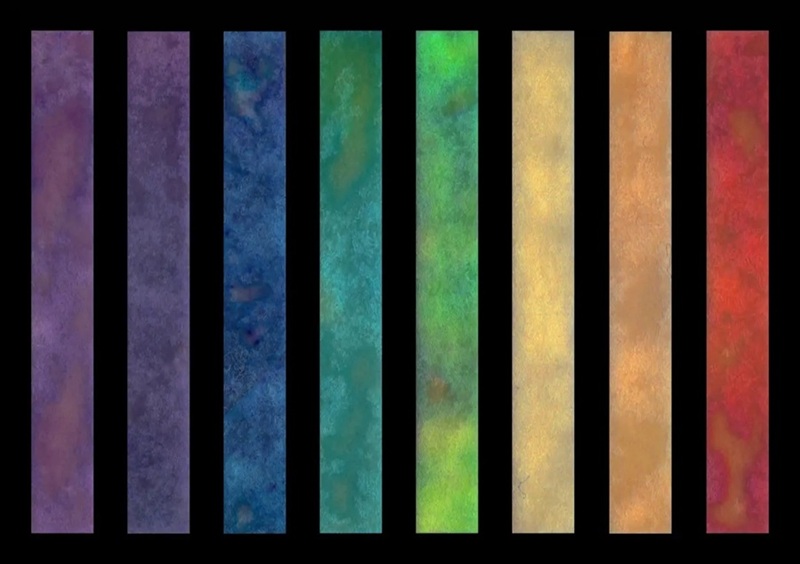
New UTI Diagnosis Method Delivers Antibiotic Resistance Results 24 Hours Earlier
Urinary tract infections affect around 152 million people every year, making them one of the most common bacterial infections worldwide. In routine medical practice, diagnosis often relies on rapid urine... Read more
Breakthroughs in Microbial Analysis to Enhance Disease Prediction
Microorganisms shape human health, ecosystems, and the planet’s climate, yet identifying them and understanding how they are related remains a major scientific challenge. Even with modern DNA sequencing,... Read morePathology
view channel
AI Tool Simultaneously Identifies Genetic Mutations and Disease Type
Interpreting genetic test results remains a major challenge in modern medicine, particularly for rare and complex diseases. While existing tools can indicate whether a genetic mutation is harmful, they... Read more
Rapid Low-Cost Tests Can Prevent Child Deaths from Contaminated Medicinal Syrups
Medicinal syrups contaminated with toxic chemicals have caused the deaths of hundreds of children worldwide, exposing a critical gap in how these products are tested before reaching patients.... Read more
Tumor Signals in Saliva and Blood Enable Non-Invasive Monitoring of Head and Neck Cancer
Head and neck cancers are among the most aggressive malignancies worldwide, with nearly 900,000 new cases diagnosed each year. Monitoring these cancers for recurrence or relapse typically relies on tissue... Read moreTechnology
view channel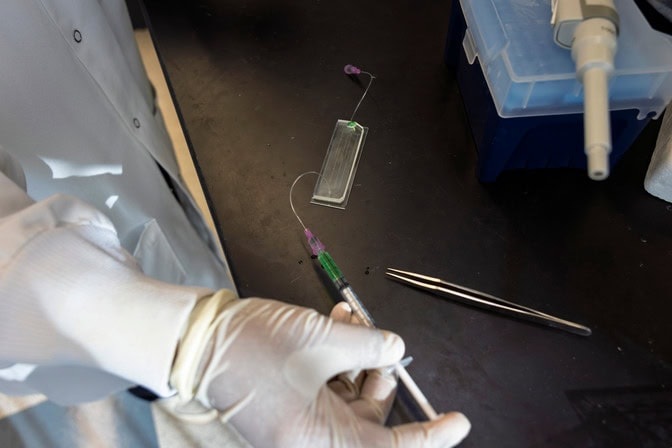
Diagnostic Chip Monitors Chemotherapy Effectiveness for Brain Cancer
Glioblastoma is one of the most aggressive and fatal brain cancers, with most patients surviving less than two years after diagnosis. Treatment is particularly challenging because the tumor infiltrates... Read more
Machine Learning Models Diagnose ALS Earlier Through Blood Biomarkers
Amyotrophic lateral sclerosis (ALS) is a rapidly progressive neurodegenerative disease that is notoriously difficult to diagnose in its early stages. Early symptoms often overlap with other neurological... Read moreIndustry
view channel
BD and Penn Institute Collaborate to Advance Immunotherapy through Flow Cytometry
BD (Becton, Dickinson and Company, Franklin Lakes, NJ, USA) has entered into a strategic collaboration with the Institute for Immunology and Immune Health (I3H, Philadelphia, PA, USA) at the University... Read more











